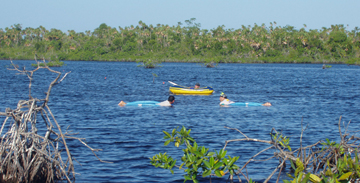 At its peak,
1,400 years ago, the 2-million-strong Maya population needed salt, and lots
of it, to survive in the heat of Central America. Used for cooking and preserving
food, the mineral represented a crucial part of society. Scientists have long
thought the salt came from large-scale production on the northern side of the
Yucatan peninsula or from mines in the interior of Guatemala. Last year, however,
an archaeological team found a wealth of new Maya sites in a saltwater lagoon
off the coast of Belize, which provide strong evidence that salt was mass-produced
there to feed the empire.
At its peak,
1,400 years ago, the 2-million-strong Maya population needed salt, and lots
of it, to survive in the heat of Central America. Used for cooking and preserving
food, the mineral represented a crucial part of society. Scientists have long
thought the salt came from large-scale production on the northern side of the
Yucatan peninsula or from mines in the interior of Guatemala. Last year, however,
an archaeological team found a wealth of new Maya sites in a saltwater lagoon
off the coast of Belize, which provide strong evidence that salt was mass-produced
there to feed the empire.Archaeologists snorkeled through mangrove forests in a saltwater lagoon off the coast of Belize in search of Maya artifacts. The group found 41 new salt-production facilities, lending credence to the idea that salt was mass-produced here 1,400 years ago. Photo courtesy of Heather McKillop.
In previous excavations in this 40-square-kilometer mangrove lagoon, archaeologist Heather McKillop of Louisiana State University in Baton Rouge had located four sites that were filled with “rough-crafted” jars and bowls alongside fire hearths. The size of the jars and bowls were standardized, which seemed to indicate that salt was produced in large quantities, McKillop says. Still, “to really know if it was possible that there was enough salt produced on the coast of Belize to provide for the rest of the Maya civilization, we had to find more sites,” she says.
Snorkeling in a grid pattern at arm’s length across about 1 square kilometer of the lagoon (2.5 percent of the total area of the lagoon), McKillop and her team found 41 more sites — and left many more undiscovered due to time limitations, McKillop says. As reported in the April 12 Proceedings of the National Academy of Sciences, the team identified and documented sites based on concentrations of pottery remains and remains of wooden structures, which were present at 23 of the sites. Radiocarbon dates of some of the wooden structures range from A.D. 670 to 960, the height of the Late Classic Maya period. There is no evidence of any modern settlement or use of the lagoon, McKillop says.
All of these sites were small, probably entrepreneurial workshops, she says, clearly separated from one another. “It’s really not clear yet if the settlements were occupied at the same time or not,” McKillop says.
The jars and bowls found in the settlements were large “utilitarian pots that seemed to be made, used and discarded on the spot,” she says. The pots were probably used to boil saltwater over open fires until the water evaporated and salt cakes were left — the standard practice for producing salt across many different cultures at the time. The team also found a canoe paddle that dated to about A.D. 700 in the middle of one of the salt-production buildings, leading researchers to believe the canoe was used to transport the salt inland to the 80 Maya polities, regional jurisdictions that were home to up to 100,000 people apiece.
“It’s an exciting find,” says Tom Guderjan, an archaeologist with Texas Christian University in Fort Worth, who was not involved in the research. Archaeologists have long suspected that trade was prevalent between the coastal settlements and inland powerful polities, he says, and now they have direct evidence.
“The find opens a window into Maya society,” Guderjan says. For at least a decade, he says, a debate has been ongoing about whether salt production to feed the empire had been done at an industrial level in the north versus the entrepreneurial or household level elsewhere. “These sites clearly show that salt production was at a household level” in Belize, he says. One big remaining question though, is whether the salt workers were coastal inhabitants rather than from the inland polities, says Arlen Chase, an archaeologist with the University of Central Florida in Orlando.
Many of the 41 new sites still lie beneath about a meter of water, a thin layer of silt and a several-meter-thick layer of mangrove peat, which preserved the wooden artifacts. The next step, McKillop says, is to systematically excavate and map each of these finds as archaeologists would on dry land. McKillop says that further studies are also commencing to understand why and when these Maya sites were abandoned — whether due to inundation from sea-level rise and climate change, or whether due to the demand waning because of the collapse of the Maya empire.

